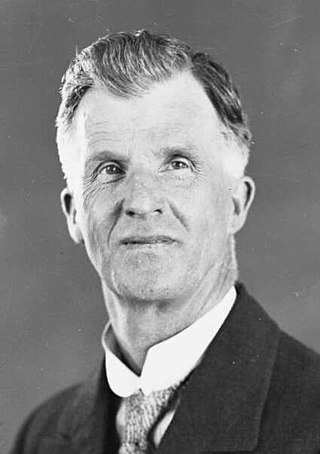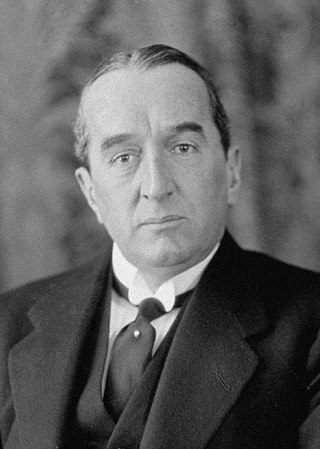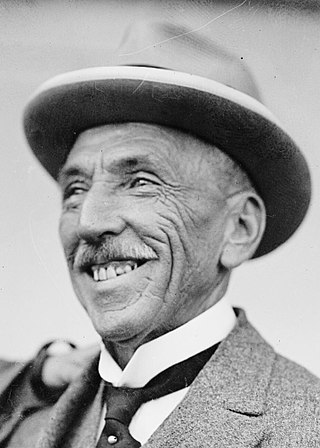
The Nationalist Party, also known as the National Party, was an Australian political party. It was formed in February 1917 from a merger between the Liberal Party and the National Labor Party, the latter formed by Prime Minister Billy Hughes and his supporters after the 1916 Labor Party split over World War I conscription. The Nationalist Party was established as a 'united' non-Labor opposition that had remained a political trend once the Labor party established itself in federal politics. The party was in government until electoral defeat in 1929. From that time it was the main opposition to the Labor Party until it merged with pro-Joseph Lyons Labor defectors to form the United Australia Party (UAP) in 1931. The party is a direct ancestor of the Liberal Party of Australia, the main centre-right party in Australia.

The Parliament of Australia is the legislative body of the federal level of government of Australia. It consists of three elements: the monarch, the Senate and the House of Representatives. It combines elements from the UK Parliament and the US Congress.

The Liberal–National Coalition, commonly known simply as the Coalition or the LNP, is an alliance of centre-right political parties that forms one of the two major groupings in Australian federal politics. The two main partners in the Coalition are the Liberal Party of Australia and the National Party of Australia. There are four federally registered parties who are part of the Coalition: Liberal, Nationals, Liberal National Party and Country Liberal Party. LNP and CLP members elected to the federal parliament are designated to sit with one of the two coalition partners, which is how it’s possible that the leaders of both federal parties are members of the Queensland LNP.

Alexander Poynton OBE was an Australian politician. He held ministerial office under Prime Minister Billy Hughes, serving as Treasurer (1916–1917), Minister for Home and Territories (1920–1921), and Postmaster-General (1921–1923).

The 1929 Australian federal election was held in Australia on 12 October 1929. All 75 seats in the House of Representatives were up for election, but there was no Senate election. The election was caused by the defeat of the Stanley Bruce-Earle Page Government in the House of Representatives over the Maritime Industries Bill, Bruce having declared that the vote on the bill would constitute a vote of confidence in his government.

The 1928 Australian federal election was held in Australia on 17 November 1928. All 75 seats in the House of Representatives and 19 of the 36 seats in the Senate were up for election. The incumbent Nationalist–Country coalition, led by Prime Minister Stanley Bruce won a record fifth consecutive election defeating the opposition Labor Party led by James Scullin.

The 1925 Australian federal election was held in Australia on 14 November 1925. All 75 seats in the House of Representatives and 22 of the 36 seats in the Senate were up for election. The incumbent Nationalist–Country coalition, led by Prime Minister Stanley Bruce, defeated the opposition Labor Party led by Matthew Charlton in a landslide. This was the first time any party had won a fourth consecutive federal election.

The 1922 Australian federal election was held in Australia on 16 December 1922. All 75 seats in the House of Representatives, and 19 of the 36 seats in the Senate were up for election. The incumbent Nationalist Party, led by Prime Minister Billy Hughes lost its majority. However, the opposition Labor Party led by Matthew Charlton did not take office as the Nationalists sought a coalition with the fledgling Country Party led by Earle Page. The Country Party made Hughes's resignation the price for joining, and Hughes was replaced as Nationalist leader by Stanley Bruce.

The 1919 Australian federal election was held on 13 December 1919 to elect members to the Parliament of Australia. All 75 seats in the House of Representatives and 19 of the 36 seats in the Senate were up for election. The incumbent Nationalist Party government won re-election, with Prime Minister Billy Hughes continuing in office.

The 1917 Australian federal election was held in Australia on 5 May 1917. All 75 seats in the House of Representatives and 18 of the 36 seats in the Senate were up for election. The incumbent Nationalist Party, led by Prime Minister Billy Hughes, defeated the opposition Labor Party led by Frank Tudor in a landslide.
The 1918 Swan by-election was a by-election for the Division of Swan in the Australian House of Representatives, following the death of the sitting member Sir John Forrest. Held on 26 October 1918, the by-election led to the election of the youngest person to be elected until 2010 to the Parliament of Australia, Edwin Corboy. It saw the conservative vote split between the Country Party and the Nationalist Party, which directly prompted the introduction of preferential voting in Australia.

John Grant "Jack" Duncan-Hughes was an Australian politician. He was a member of the Australian House of Representatives for Boothby from 1922 to 1928, of the Australian Senate for South Australia from 1932 to 1938, and of the House of Representatives for Wakefield from 1940 to 1943. He represented the Nationalist Party (1922–28) and its successor the United Australia Party.
This is a list of the members of the Australian House of Representatives in the 20th Australian Parliament, which was elected at the 1951 election on 28 April 1951. The incumbent Liberal Party of Australia led by Prime Minister of Australia Robert Menzies with coalition partner the Country Party led by Arthur Fadden defeated the Australian Labor Party led by Ben Chifley.
This is a list of the members of the Australian House of Representatives in the 18th Australian Parliament, which was elected at the 1946 election on 28 September 1946. The incumbent Australian Labor Party led by Prime Minister of Australia Ben Chifley defeated the newly formed opposition Liberal Party of Australia led by its founder Robert Menzies with coalition partner the Country Party led by Arthur Fadden.
This is a list of the members of the Australian House of Representatives in the 17th Australian Parliament, which was elected at the 1943 election on 21 August 1943. The incumbent Australian Labor Party led by Prime Minister of Australia John Curtin defeated the opposition Country Party led by Arthur Fadden with coalition partner the United Australia Party (UAP) led by Billy Hughes. On 21 February 1945, the parliamentary UAP was dissolved and replaced by the newly established Liberal Party.
This is a list of the members of the Australian House of Representatives in the 13th Australian Parliament, which was elected at the 1931 election on 19 December 1931. The incumbent Australian Labor Party led by Prime Minister of Australia James Scullin was defeated by the newly formed opposition United Australia Party led by ex-Labor Joseph Lyons with coalition partner the Country Party led by Earle Page.
This is a list of the members of the Australian House of Representatives in the 12th Australian Parliament, which was elected at the 1929 election on 12 October 1929. The incumbent Nationalist Party of Australia led by Prime Minister of Australia Stanley Bruce in power since 1923 with coalition partner the Country Party led by Earle Page was defeated by the opposition Australian Labor Party led by James Scullin. Labor won with its then largest-ever majority in the federal parliament. However major divisions within the Labor over policy responses to the Great Depression, and the subsequent creation of the United Australia Party led to thirty parliamentarians changing their party affiliation in 1931.
This is a list of the members of the Australian House of Representatives in the 11th Australian Parliament, which was elected at the 1928 election on 17 November 1928. The incumbent Nationalist Party of Australia led by Prime Minister of Australia Stanley Bruce in power since 1922 with coalition partner the Country Party led by Earle Page defeated the opposition Australian Labor Party led by Matthew Charlton.
This is a list of the members of the Australian House of Representatives in the 10th Australian Parliament, which was elected at the 1925 election on 14 November 1925. The incumbent Nationalist Party of Australia led by Prime Minister of Australia Stanley Bruce in power since 1922 with coalition partner the Country Party led by Earle Page defeated the opposition Australian Labor Party led by Matthew Charlton. The Nationalist won 11 seats, they did not take at the 1922 election, although five of them were held by Liberal Party members, who had joined the Nationalist government after Bruce became Prime Minister in February 1923.
The history of the Australian Labor Party has its origins in the Labour parties founded in the 1890s in the Australian colonies prior to federation. Labor tradition ascribes the founding of Queensland Labour to a meeting of striking pastoral workers under a ghost gum tree in Barcaldine, Queensland in 1891. The Balmain, New South Wales branch of the party claims to be the oldest in Australia. Labour as a parliamentary party dates from 1891 in New South Wales and South Australia, 1893 in Queensland, and later in the other colonies.











